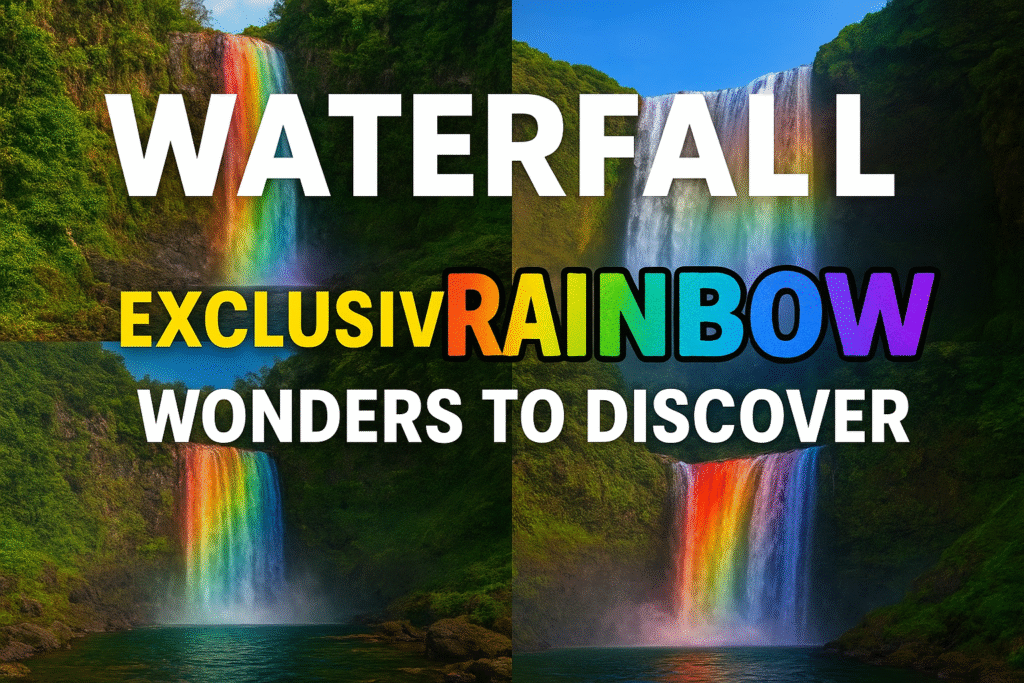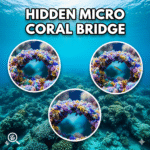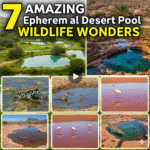Where Water Meets Light
There’s a kind of magic that happens when sunlight, mist, and timing align just right. It’s not the typical rainbow that appears after a rainstorm — it’s something far more elusive, a waterfall exclusive rainbow that emerges only where falling water meets the sun’s golden touch.
Unlike common rainbows, these rare arcs of color can only be seen in specific waterfalls around the world. They appear for minutes or even seconds, depending on the time of day, the season, and the angle of the sun. For those lucky enough to witness one, it’s like watching nature breathe color into the world.
From Iceland’s Skógafoss to Africa’s Victoria Falls, and from Yosemite’s midday glow to Croatia’s hidden cascades, here are seven waterfalls where light performs its most dazzling show — creating ephemeral arcs of brilliance that photographers, scientists, and travelers alike dream of capturing.
1. Yosemite Falls, USA – Daily Midday Rainbow
Few places capture the majesty of nature like Yosemite National Park, and few spectacles within it are as mesmerizing as the waterfall exclusive rainbow that forms at Yosemite Falls.
As sunlight strikes the fine spray near noon, a radiant arc appears behind the fall’s lower section, creating a moment so perfect it seems almost staged. This daily rainbow has become a pilgrimage for photographers who gather with tripods and polarized filters to catch that fleeting color spectrum.

The effect is caused by water droplets suspended in air refracting and reflecting sunlight at just the right angle — usually between 42° and 44°. If you’re standing at the right place along the valley trail, you can see the rainbow forming behind the cascading water, its colors glowing against Yosemite’s granite walls.
Best Time to See:
Late spring to early summer (May–July) when the water flow is strongest and sunlight is high.
Pro Tip:
Visit around 11:30 AM to 12:30 PM and stand slightly right of the lower falls viewing area for the best alignment.
2. Skógafoss, Iceland – The Rainbow Curtain
In Iceland, where waterfalls dot the landscape like jewels, Skógafoss is the crown that catches the light. On sunny afternoons, this 60-meter-high waterfall becomes home to one of the most reliable waterfall exclusive rainbows on Earth.
When the wind shifts and the mist drifts toward the viewing area, visitors are enveloped in a shimmering rainbow curtain. Sometimes, two appear — a double rainbow that arcs perfectly across the gorge.
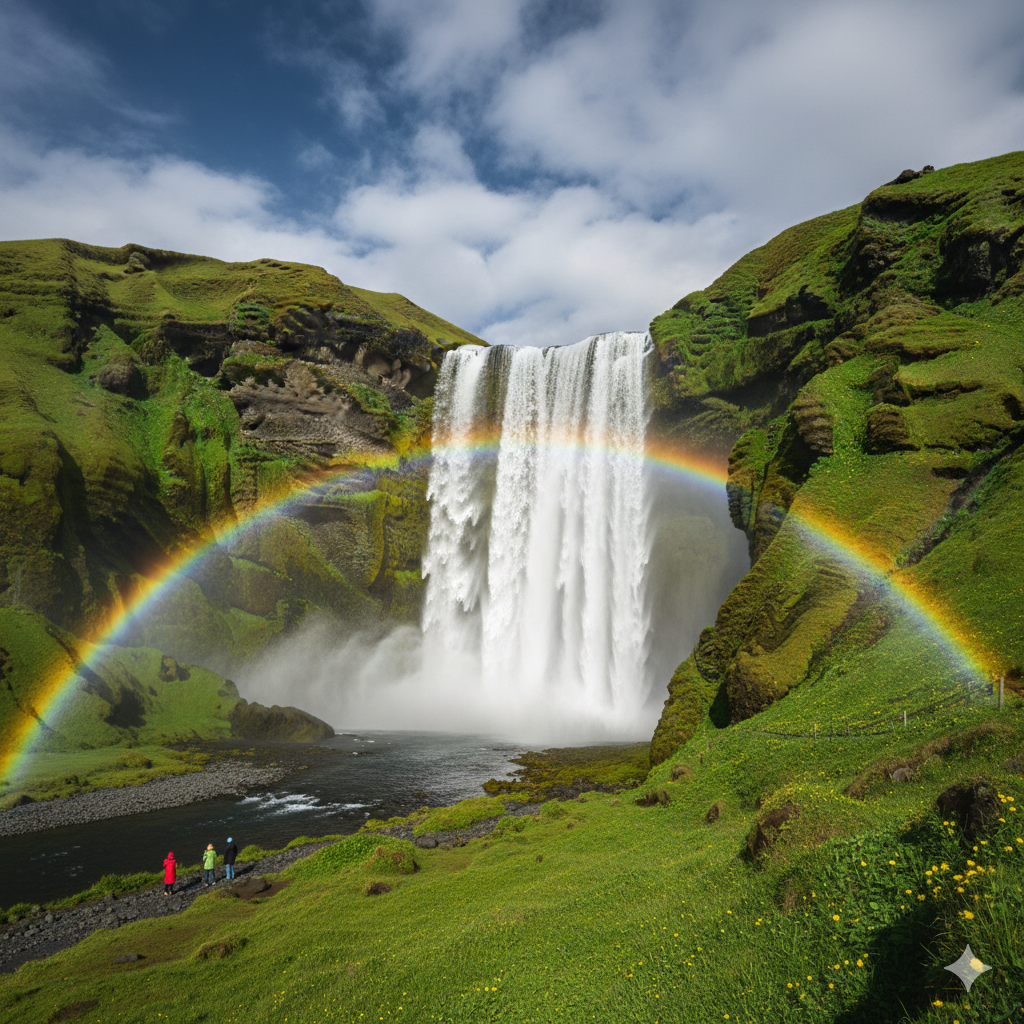
Locals often joke that the “pot of gold” at its end is Iceland itself. Photographers, on the other hand, simply call it a dream location.
Best Time to See:
Summer months, between 2 PM and 4 PM, when the sun’s angle is ideal.
Pro Tip:
Climb the right-hand staircase beside the waterfall — the higher you go, the more dramatic the rainbow view becomes.
3. Kaieteur Falls, Guyana – Hidden Rainbow Gorge
Deep in the Amazonian jungle, Kaieteur Falls remains one of the least-visited natural wonders in the world. Here, a waterfall exclusive rainbow emerges only when morning sunlight pierces the mist-filled gorge.
At 226 meters tall — about five times the height of Niagara Falls — Kaieteur’s sheer power creates a perpetual mist cloud. The moment the rising sun hits this foggy veil, an ethereal rainbow forms deep in the canyon.
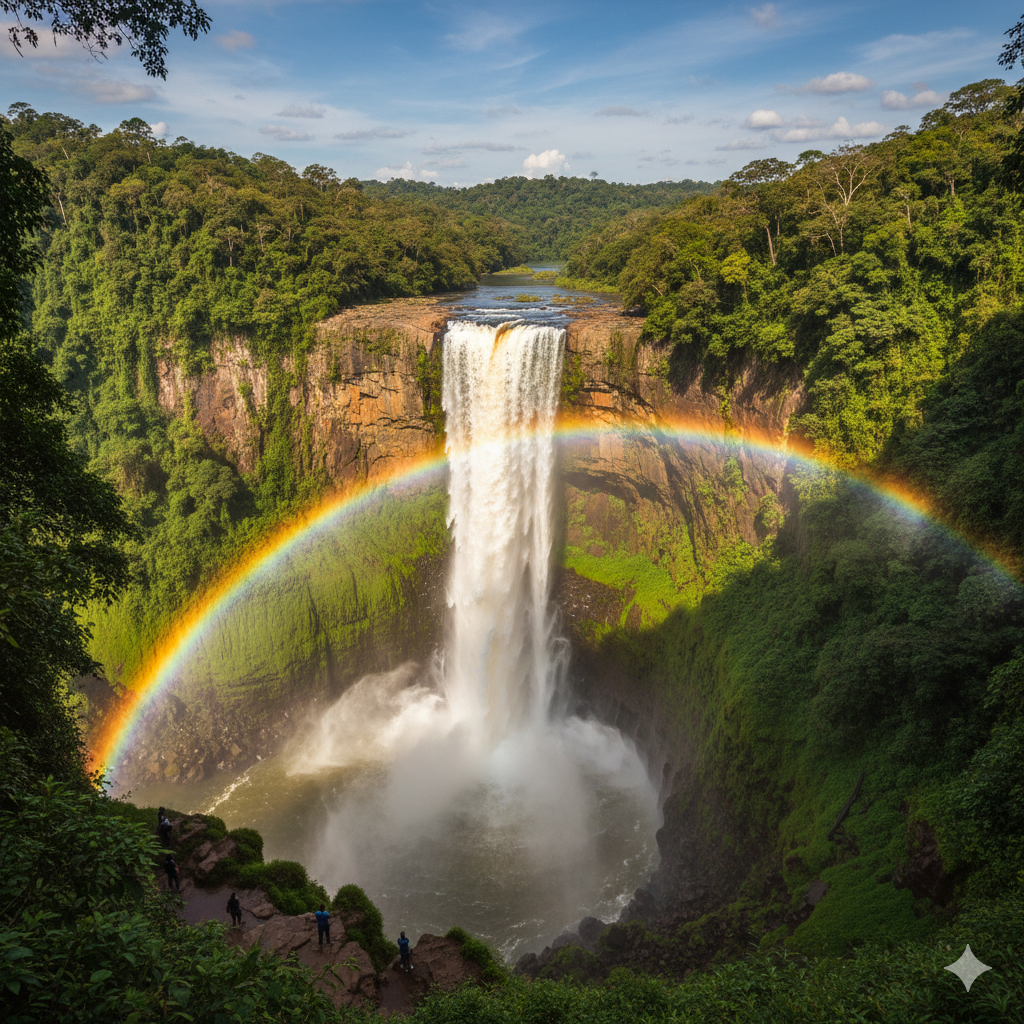
Unlike Skógafoss or Yosemite, this rainbow can only be seen from certain lookout points or by helicopter. It’s fleeting, often lasting less than ten minutes. But in that short time, the jungle seems to glow.
Best Time to See:
Early morning, between 8 AM and 9 AM.
Pro Tip:
Book a guided flight from Georgetown — aerial tours give the most breathtaking views of both the falls and the rainbow arc.
4. Seljalandsfoss, Iceland – Walk-Behind Rainbow
If you’ve ever dreamed of standing inside a rainbow, Seljalandsfoss is your destination. This Icelandic marvel is one of the few waterfalls in the world that you can walk behind — and that’s exactly where its waterfall exclusive rainbow appears.

In the late afternoon, sunlight streams through the cascading water, forming a luminous arc that appears within the cave-like trail behind the falls. Visitors often gasp as they realize they’re walking through the shimmering glow itself.
It’s a photographer’s paradise, and the surreal 360° view — the sound of rushing water, the glow of the sun, and the halo of colors — is unforgettable.
Best Time to See:
Around 5 PM in summer when the sun dips low enough to hit the falls directly.
Pro Tip:
Bring a waterproof jacket and a camera cover — the mist behind the falls can be intense!
5. Victoria Falls, Zambia/Zimbabwe – Lunar Rainbows
Some rainbows form in sunlight — others in moonlight.
At Victoria Falls, one of Africa’s grandest wonders, lunar rainbows or “moonbows” appear several nights each month. These waterfall exclusive rainbows are visible when bright moonlight refracts through the mist rising from the falls’ enormous chasm.
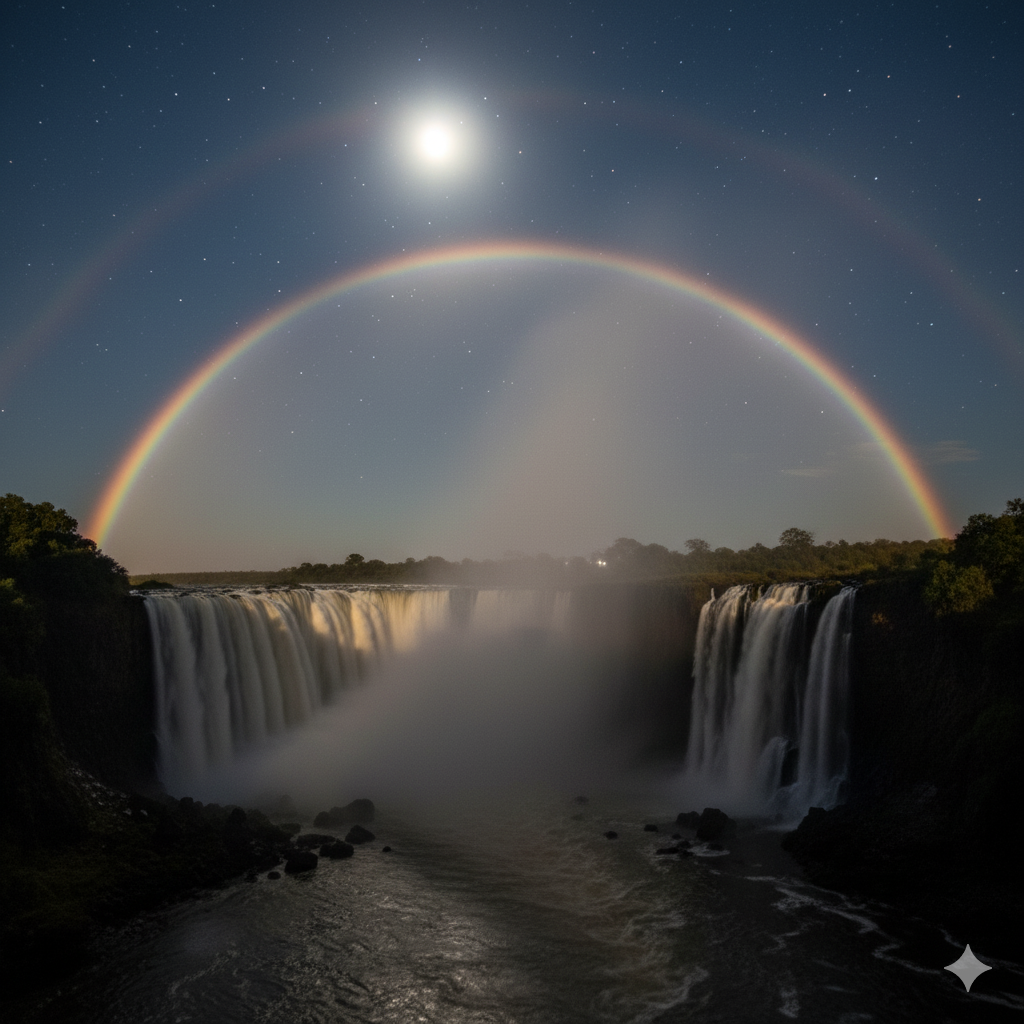
Unlike daylight rainbows, these arcs are faint, silvery, and almost ghostlike. Under long-exposure photography, they reveal soft colors of blue and violet — a secret rainbow glowing in the dark.
Best Time to See:
During full moon nights from March to July, when mist volume and moonlight are strongest.
Pro Tip:
Book a night tour from the Zambian side — the Devil’s Cataract viewpoint offers the clearest moonbow views.
6. Iguazu Falls, Brazil/Argentina – Constant Spectrum
If one waterfall could claim to always wear a rainbow, it’s Iguazu Falls.
Straddling the border of Brazil and Argentina, this massive system of 275 cascades creates a continuous mist so thick it often produces a constant waterfall exclusive rainbow from sunrise to sunset.
Walk along the Devil’s Throat walkway, and you’ll be surrounded by shimmering arcs that shift with every step. It’s one of the few places on Earth where you can see multiple rainbows forming at once, stretching across the jungle horizon.

Best Time to See:
Morning and midday under clear skies — the more sunlight, the more intense the colors.
Pro Tip:
Visit both the Brazilian and Argentinian sides — each offers different rainbow angles and reflections.
7. Plitvice Lakes, Croatia – Hidden Cascade Rainbow
Tucked within Croatia’s emerald forests, Plitvice Lakes National Park holds a quieter kind of beauty. Here, smaller waterfalls form subtle waterfall exclusive rainbows during the afternoon when sunlight filters through the limestone mist.
They’re faint and short-lived, but when they appear, they seem to hang suspended over the turquoise lakes below — tiny arcs of light that disappear with a breath of wind.
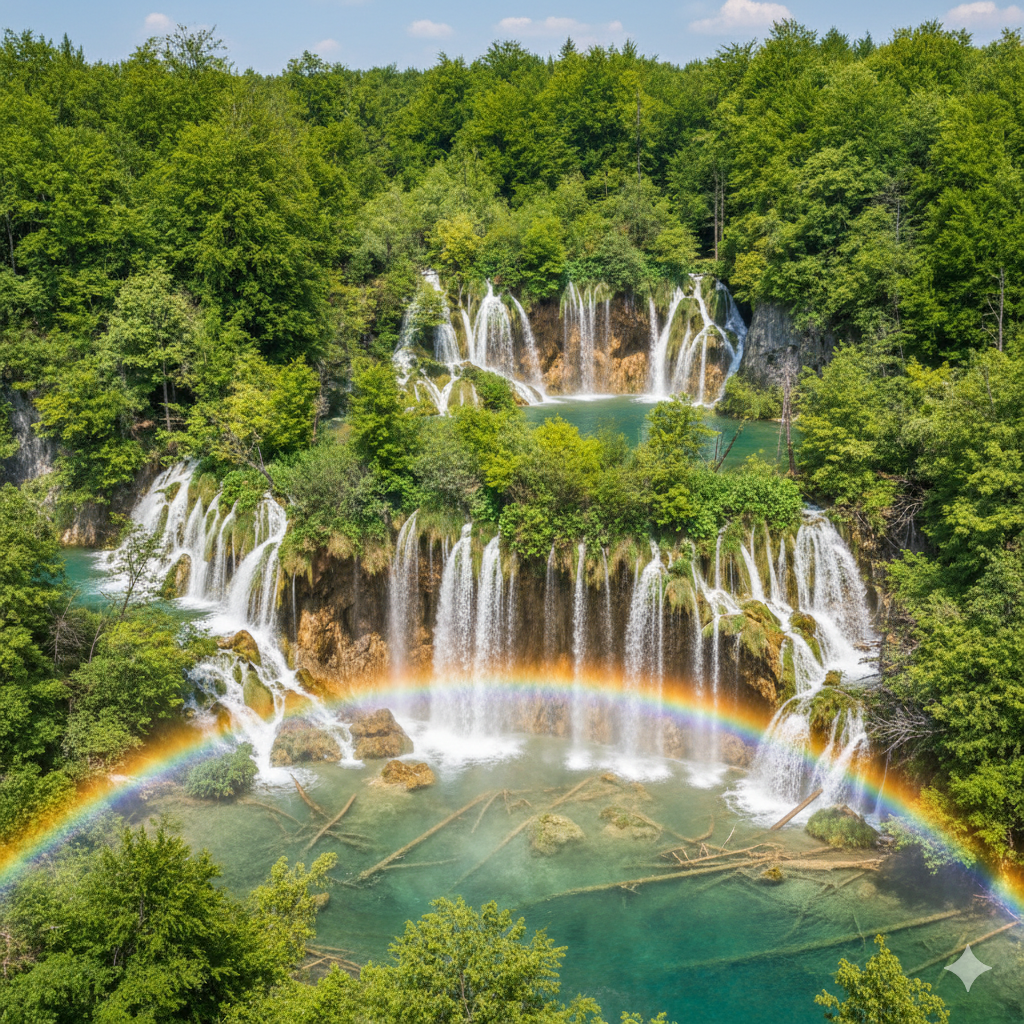
The charm of Plitvice is not in grandeur but in serenity. The gentle hum of water, the whisper of leaves, and a sudden rainbow dancing across the cascades — it’s nature’s poetry at its softest.
Best Time to See:
Early afternoon in late spring or summer.
Pro Tip:
Use the wooden walkways near the Lower Lakes for the best chance to catch the fleeting rainbow.
The Science Behind Waterfall Exclusive Rainbow
So what exactly causes these magical displays?
Every waterfall exclusive rainbow is a combination of three key factors: sunlight, mist, and observer position.
When sunlight enters a spherical water droplet, it slows down, bends (refraction), reflects off the inside surface, and then exits — splitting into colors.
To see the rainbow, you must stand with your back to the sun at roughly a 42° angle to the mist.
At waterfalls, mist density and droplet size vary constantly — meaning rainbows appear and disappear within seconds. Some are partial, others full semicircles, and a few rare ones — like Seljalandsfoss — can appear as complete 360° rings.
🌍 Global Importance — A Reminder of Fragility
These natural light shows are not just photogenic — they’re indicators of a healthy hydrological and atmospheric system.
When water levels drop due to drought, or mist density changes from deforestation or pollution, waterfall exclusive rainbow can fade or vanish entirely.
Hidden Micro Coral Bridge Wonders You Must Explore
That’s why preserving these sites is more than a tourism effort — it’s environmental stewardship. Protecting water flow and maintaining air quality ensures future generations can still witness this breathtaking blend of physics and beauty.
Frequently Asked Questions Waterfall Exclusive Rainbow
Q1: What is a waterfall exclusive rainbow?
A rare rainbow that forms only when sunlight refracts through mist produced by waterfalls — visible from specific angles or times of day.
Q2: Why do some appear daily and others rarely?
Because rainbow visibility depends on sunlight strength, mist density, and angle of view. Some waterfalls have the ideal geometry for daily appearances, while others depend on season or time.
Q3: Can you see these rainbows during rain?
No. They require direct sunlight. Rain clouds usually block the necessary light for rainbow formation.
Q4: What equipment is best for photographing them?
A DSLR or mirrorless camera, wide-angle lens, and a circular polarizing filter help capture vivid colors without glare.
Q5: Are there night rainbows?
Yes — called moonbows. Victoria Falls and Yosemite both host these rare lunar rainbows during full moon nights.
Traveler Advise — Waterfall Exclusive Rainbow
Waterfall exclusive rainbows are nature’s most fleeting artwork — a perfect meeting of physics and wonder.
They remind us that beauty doesn’t always wait; it appears briefly and rewards those who take the time to look up, wait, and see the world differently.
From the thunderous roar of Victoria Falls to the quiet song of Plitvice Lakes, these seven wonders reveal a universal truth — even the simplest elements, water and light, can create miracles.
So, the next time you stand before a waterfall, pause. The world might just be about to turn into color.

